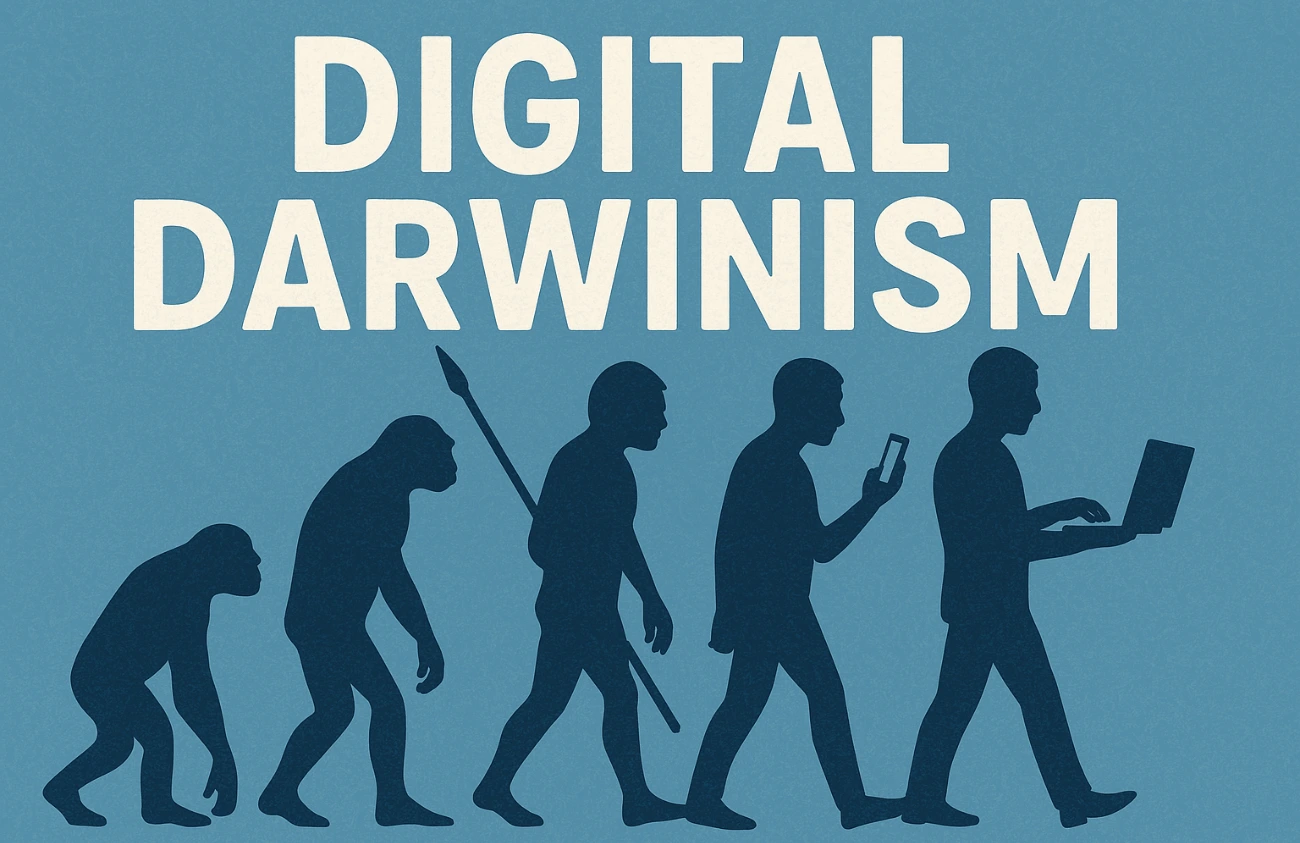DIGITAL DARWINISM: How to Adapt and Thrive in the Evolving Market

Digital Darwinism is no longer a distant concept—it’s unfolding in real time. As new technologies reshape industries, businesses face a critical choice: evolve with agility or risk being left behind. The pressure to undergo digital transformation in business stems not only from technological shifts but also from changes in consumer behaviour, organizational culture, and societal evolution. Technology companies, digital transformation firms and even legacy technology businesses must embrace modern technology and rethink their organizational structures to survive and thrive.
Causes of Digital Darwinism
The forces fuelling Digital Darwinism are relentless. From rapid technological development to shifting consumer expectations, understanding these causes is key to transformation.
1.Rapid Technological Advancements
Emerging innovations are moving faster than most companies can adapt. Digital technologies have blurred industry boundaries and redefined success metrics.
Emergence of Disruptive, Shorter Tech Lifecycles
The lifecycle of current technology has compressed drastically. What was once revolutionary becomes obsolete within months.
- Tech companies like startups embrace lean innovation, outpacing traditional players.
- The rise of digital companies and platforms forces incumbents to rethink their product strategies.
- Consumers expect instant updates and seamless upgrades—putting pressure on legacy systems.
Moore’s Law in Action
Moore’s Law, which predicts the doubling of computing power every two years, accelerates disruption.
- As future technology grows exponentially, cost drops and adoption accelerate.
- Businesses must pivot quickly to integrate new capabilities—from AI to IoT.
- Those relying on outdated systems struggle to keep up with this fast-paced evolution.
2.Shifting Consumer Behaviour
Consumers have become digital-first—demanding personalization, speed, and convenience.
Digital-First Expectations
Expectations around mobile apps, voice assistants, and digital transformation in the workplace are now standard.
- Technology companies are increasingly judged on user experience, not just product features.
Decline of Physical Media
- Physical DVDs, CDs, and paper statements are being transitioned to streaming, downloads, and cloud access.
- The dominance of digital technologies means distribution models must evolve.
Social Media Influence
- Platforms like Instagram and X shape brand perception.
- Viral trends and influencer-driven commerce drive consumer decisions at lightning speed.
3.Organizational Inertia
While the world shifts, many organizations stay rooted in tradition—unable or unwilling to evolve.
Resistance to Change
- Outdated thinking resists integration of new technologies.
- Failure to adopt digital transformation in the workplace leads to employee disengagement.
Failure to Innovate
- Bureaucratic hurdles and a focus on immediate returns often stifle innovation.
- Without embracing emerging technologies, companies lose relevance.
Siloed Operations
- Rigid organizational structures prevent collaboration and speed.
- Data and knowledge trapped in departmental silos limits agility.
4.Societal Evolution
The context around business is changing—people, places, and behaviours are evolving digitally.
Global Connectivity
- Digital infrastructure has connected markets, creating global competition.
- Technology businesses now compete with startups halfway across the world.
Generational Shifts
- Gen Z and Millennials are digital natives with high expectations of tech.
- Workplace culture must adapt to this mindset and embrace digital transformation company philosophies.
Pandemic Acceleration
- COVID-19 forced organizations into remote work and virtual customer service.
- Those with modern technology and scalable platforms survived; others struggled.
5.Data Explosion
Data is everywhere, but harnessing it remains a challenge.
Big Data and Analytics
- Capturing data is no longer enough—digital transformation depends on actionable insight.
- Companies that leverage analytics gain competitive advantage.
Cybersecurity Demands
As data grows, so do threats.
- Security breaches erode consumer trust and stall transformation efforts.
Thriving in the Era of Digital Darwinism: Core Strategies for Success
Survival is no longer about being the biggest—it’s about being the smartest, fastest, and most adaptable. Here’s how organizations can evolve.
1.Embrace Change Proactively
- A successful digital transformation in business hinges more on a change in mindset than on mere technology upgrades.
- Leaders must anticipate disruption and prepare accordingly.
2.Invest in Digital Infrastructure
- Scalable cloud systems, AI platforms, and data lakes are foundational.
- Modernizing infrastructure supports innovation and resilience.
3.Prioritize Customer-Centricity
- Personalization through digital technologies builds loyalty.
- Understand customer journeys using tools like CRM and predictive analytics.
4.Break Down Silos
- Cross-functional teams foster speed and creativity.
- Flattened organizational structures empower collaboration and transparency.
5.Upskill Continuously
- Train teams in current technology tools, agile methods, and data literacy.
- Learning organizations are more adaptive to technological development.
- Individuals can take charge of their upskilling journey by enrolling in digital marketing courses offered by institutes like Omit.
6.Data-Driven Decision Making
- Data isn’t just for understanding history; it’s for forecasting what’s next.
- Metrics should inform strategic pivots and product innovation.
7.Operational Agility
- Flexibility in processes and decision-making speeds transformation.
- Agile methods ensure rapid iteration and response to market shifts.
8.Ethical and Sustainable Tech Adoption
- Evaluate the long-term impact of new technologies on society and the planet.
- Ethical AI, data privacy, and sustainability matter to consumers and regulators.
9.Mindset Shift
- View disruption as opportunity, not threat.
- Leaders must champion innovation and cultivate a culture ready for continuous transformation.
Conclusion: Adaptation Is the New Competitive Advantage
In this era of Digital Darwinism, those who thrive aren’t the strongest—they’re the most adaptable. The digital landscape evolves daily, and businesses must evolve with it. Through strategic digital transformation, the adoption of modern technology, and a deep focus on customer needs, organizations can redefine success.
Whether you’re a digital transformation company like Citric IDM Solutions or a traditional technology business reevaluating your strategy, the mandate is clear: invest in emerging technologies, reshape your organizational structure, and embed agility at the core of your operations.
– ARUN MONNAPPA P.C.
